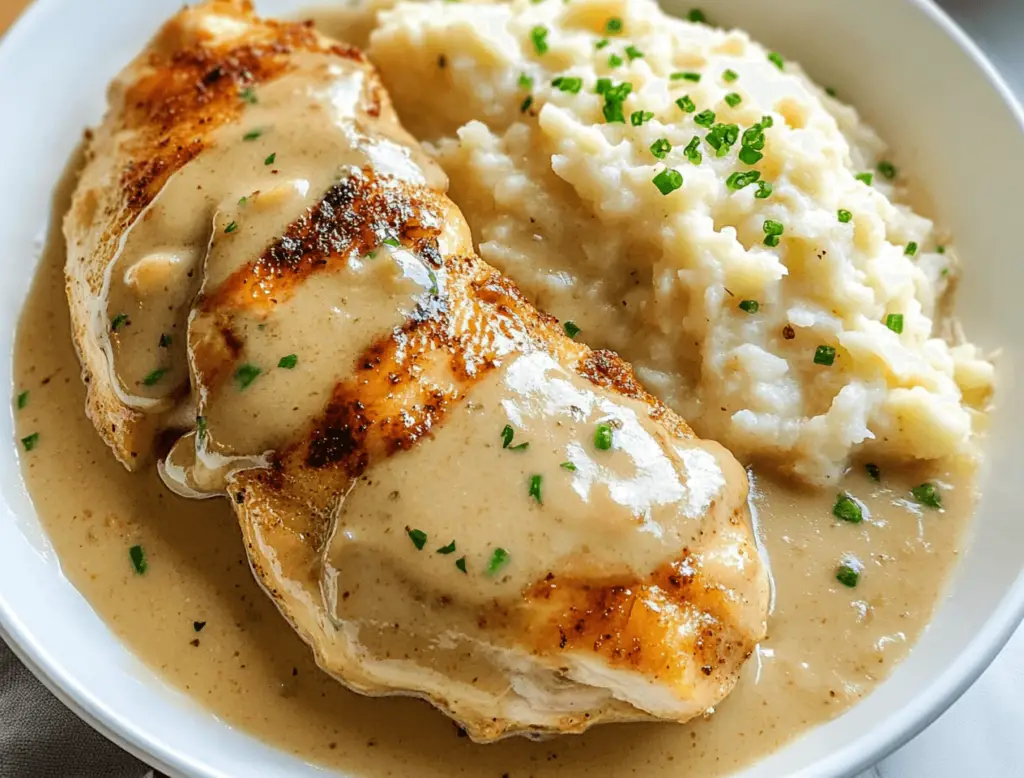Chicken and Gravy is a comforting, classic dish that has been a staple in kitchens around the world for generations. This dish brings together tender, juicy chicken with a rich, savory gravy, creating a meal that’s both hearty and satisfying. Whether you’re making it for a cozy family dinner or a special occasion, Chicken and Gravy is sure to please everyone at the table. The simplicity of the ingredients and the ease of preparation make it a go-to recipe when you’re in need of a delicious, no-fuss meal.

This recipe can be adapted to suit your preferences, whether you like your gravy thick and creamy or with a touch of spice. Serve it over mashed potatoes, rice, or alongside some steamed vegetables for a complete and comforting meal. Chicken and Gravy is a versatile dish that never fails to deliver on flavor and comfort.
Overview of Chicken and Gravy
Chicken and Gravy is a dish that pairs well-cooked, tender chicken with a savory gravy made from pan drippings, broth, and often a touch of cream or flour to thicken. The gravy is rich and flavorful, typically seasoned with herbs like thyme, rosemary, or sage. This dish is incredibly versatile and can be made using different cuts of chicken—whether you prefer boneless breasts, thighs, or even a whole roasted chicken. The key to a great Chicken and Gravy lies in the balance of flavors in the gravy and ensuring the chicken is cooked to perfection.
Brief History and Cultural Significance of Chicken and Gravy
The origins of Chicken and Gravy are deeply rooted in comfort food traditions across many cultures. In American Southern cuisine, this dish is often associated with Sunday dinners and family gatherings, where the chicken is fried or baked and the gravy is made from the flavorful pan drippings. In European cuisine, variations of Chicken and Gravy have been served for centuries, often accompanied by root vegetables or dumplings. The dish represents a simple yet hearty meal, offering a taste of home and tradition in every bite.
Over the years, Chicken and Gravy has evolved with countless regional variations, each adding its own unique twist to the classic recipe. Despite these variations, the essence of the dish remains the same: tender chicken paired with a luscious, savory gravy, making it a beloved comfort food around the world.
Preparation Phase & Tools to Use
Recipe details
- Prep Time: 15 minutes
- Cook Time: 40 minutes
- Cool Time: 5 minutes
- Total Time: 1 hour
- Servings: 4-6 servings
- Yield: 4-6 portions of Chicken and Gravy
Essential Tools and Equipment
To make Chicken and Gravy, you will need the following tools:
- Skillet or Sauté Pan: For browning the chicken and making the gravy.
- Tongs or Spatula: To turn the chicken and remove it from the pan.
- Whisk: Essential for creating a smooth, lump-free gravy.
- Measuring Cups and Spoons: For accurate measurement of ingredients.
- Cutting Board and Knife: To prep any additional ingredients like garlic or herbs.
Importance of Each Tool
- Skillet or Sauté Pan: A heavy-bottomed pan is ideal for evenly browning the chicken and creating a rich base for the gravy.
- Tongs or Spatula: Helps in handling the chicken safely while cooking.
- Whisk: Crucial for blending the gravy ingredients smoothly and ensuring a velvety texture.
- Measuring Cups and Spoons: Ensures you add the correct amounts of each ingredient, particularly when making the gravy.
- Cutting Board and Knife: Necessary for preparing fresh herbs or any additional ingredients you choose to include.
Preparation Tips
- Season the Chicken Well: Season the chicken with salt, pepper, and your choice of herbs before cooking to enhance the flavor.
- Don’t Skip the Searing: Searing the chicken in a hot pan before simmering it in the gravy adds depth to the flavor and locks in the juices.
- Deglaze the Pan: After removing the chicken, deglaze the pan with broth or wine to capture all the flavorful bits left behind. This forms the base of your gravy.
- Control the Gravy Consistency: Adjust the thickness of the gravy by adding more broth for a thinner gravy or more flour (or cornstarch) for a thicker consistency.
- Let the Chicken Rest: After cooking, let the chicken rest for a few minutes before serving to allow the juices to redistribute, keeping it moist and tender.
Ingredients List
- 4 boneless, skinless chicken breasts (or thighs)
- 2 tablespoons olive oil
- 1/2 teaspoon salt
- 1/4 teaspoon black pepper
- 1 teaspoon garlic powder
- 1 teaspoon dried thyme (or other herbs)
- 2 cups chicken broth
- 1/4 cup all-purpose flour
- 1/2 cup heavy cream (optional for creamy gravy)
- 1/4 cup white wine (optional for deglazing)
- Fresh parsley (for garnish, optional)
Step-by-Step Instructions
- Season the chicken: Pat the chicken dry with paper towels and season both sides with salt, pepper, garlic powder, and dried thyme.
- Sear the chicken: Heat the olive oil in a large skillet over medium-high heat. Add the chicken and sear for 4-5 minutes on each side, until golden brown. Remove the chicken from the skillet and set aside.
- Make the gravy: Reduce the heat to medium. If using, add the white wine to deglaze the pan, scraping up any browned bits. Whisk in the flour and cook for 1-2 minutes to create a roux. Gradually whisk in the chicken broth until smooth.
- Simmer the chicken: Return the chicken to the skillet, reduce the heat to low, and cover. Let it simmer for 20-25 minutes, or until the chicken is cooked through and the gravy has thickened.
- Optional: Add cream: For a creamier gravy, stir in the heavy cream during the last 5 minutes of cooking.
- Serve: Garnish with fresh parsley and serve the chicken and gravy over mashed potatoes, rice, or your favorite side dish.
Side Dish Recommendations
Chicken and Gravy is a versatile dish that pairs well with a variety of side dishes, each adding a unique element to the meal. Here are some delicious sides that perfectly complement the rich, savory flavors of Chicken and Gravy:
1. Mashed Potatoes
Mashed potatoes are a classic choice to serve with Chicken and Gravy. The creamy, buttery potatoes soak up the flavorful gravy, making each bite indulgent and comforting. You can also try variations like Cheesy Garlic Mashed Potatoes for an extra layer of flavor.
2. Buttered Noodles
Buttered noodles provide a simple yet satisfying base for Chicken and Gravy. The noodles, tossed in butter and lightly seasoned with salt and pepper, complement the savory gravy without overpowering it, creating a balanced and comforting dish.
3. Steamed Vegetables
Steamed vegetables such as green beans, broccoli, or carrots add a fresh and healthy element to the meal. The crispness of the vegetables contrasts nicely with the tender chicken and smooth gravy, offering a lighter, more balanced bite.
4. Rice Pilaf
Rice pilaf is a wonderful side that pairs well with the rich flavors of Chicken and Gravy. The fluffy rice, often cooked with broth and seasoned with herbs, absorbs the gravy beautifully, making each mouthful flavorful and satisfying. For added texture and flavor, you can mix in toasted nuts or dried fruit.
5. Biscuits
Buttery, flaky biscuits are another great accompaniment to Chicken and Gravy. They can be used to mop up the gravy, adding a delicious, soft texture to each bite. Homemade or store-bought, biscuits elevate the meal with their comforting, down-home appeal.
6. Roasted Vegetables
Roasted vegetables, such as potatoes, carrots, and Brussels sprouts, offer a caramelized, slightly sweet flavor that complements the savory chicken and gravy. The roasting process brings out the natural sweetness of the vegetables, which pairs perfectly with the richness of the gravy.
7. Cornbread
Cornbread adds a slightly sweet and crumbly texture that pairs well with the savory gravy. The contrast between the moist cornbread and the rich gravy creates a delightful combination, especially when served warm.
8. Creamed Spinach
Creamed spinach offers a rich, velvety texture that complements the smooth gravy. The earthy flavor of spinach, combined with a creamy sauce, pairs wonderfully with the chicken, adding both flavor and nutritional value to the meal.
Nutritional Information & Health Benefits
Understanding the nutritional content of Chicken and Gravy and its pairings can help you enjoy this comforting meal in a balanced way.
- Calories: Chicken and Gravy can range from 300-500 calories per serving, depending on the ingredients and portion sizes.
- Protein: Chicken is a good source of lean protein, essential for muscle repair and overall health.
- Fat: The fat content primarily comes from the chicken skin, gravy, and any added butter or cream. Using skinless chicken and reducing cream can lower the fat content.
- Carbohydrates: The sides you choose, such as mashed potatoes or rice, will contribute to the carbohydrate content of the meal.
- Vitamins and Minerals: Depending on the sides, you can increase your intake of vitamins (like vitamin A from carrots) and minerals (like potassium from potatoes).
Health Benefits
- Protein-Rich: Chicken provides a high-quality source of protein, which is vital for maintaining muscle mass and supporting immune function.
- Versatile Sides: Pairing the chicken with vegetables like spinach or broccoli boosts the meal’s fiber, vitamins, and antioxidants, contributing to overall health.
- Customizable Fat Content: By choosing leaner cuts of chicken and opting for lighter gravies, you can adjust the fat content to suit your dietary needs.
Common Mistakes to Avoid & How to Perfect the Recipe
1. Overcooking the Chicken
- Mistake: Overcooking can result in dry, tough chicken.
- Solution: Cook the chicken until it reaches an internal temperature of 165°F (75°C) and no longer, to ensure it remains juicy and tender.
2. Lumpy Gravy
- Mistake: Gravy can become lumpy if the flour isn’t properly mixed in or if the liquid is added too quickly.
- Solution: Whisk the flour into the pan drippings or butter thoroughly before slowly adding the broth, ensuring a smooth consistency.
3. Using Low-Quality Broth
- Mistake: Using a low-quality broth can result in a bland gravy.
- Solution: Use a high-quality chicken broth or homemade stock to enhance the flavor of the gravy. You can also add a splash of white wine or a bit of soy sauce for extra depth.
4. Skipping the Deglazing
- Mistake: Not deglazing the pan can lead to missed flavor opportunities.
- Solution: Always deglaze the pan with broth, wine, or water after searing the chicken to incorporate all those flavorful bits into the gravy.
5. Not Letting the Chicken Rest
- Mistake: Cutting into the chicken immediately after cooking can cause the juices to run out, leaving the meat dry.
- Solution: Let the chicken rest for a few minutes before slicing to allow the juices to redistribute, keeping the meat moist.
Tips, Notes, Storing, and Reheating
Tips for Perfect Chicken and Gravy
- Use Bone-In Chicken: Bone-in chicken, such as thighs or drumsticks, adds extra flavor to the gravy as it cooks. The bones release more flavor into the sauce, resulting in a richer and more robust taste.
- Sear the Chicken Properly: Searing the chicken over high heat before simmering it in the gravy creates a golden-brown crust that enhances the overall flavor. This step also locks in the juices, ensuring the chicken stays moist.
- Taste as You Go: Always taste the gravy before serving to adjust the seasoning. A pinch of salt, pepper, or even a splash of lemon juice can brighten up the flavors and make the dish even more delicious.
- Thicken Gradually: When making the gravy, add the flour or cornstarch gradually while whisking continuously to avoid lumps. If the gravy becomes too thick, you can always thin it with a little extra broth or water.
- Let the Chicken Rest: After cooking, let the chicken rest for a few minutes before slicing or serving. This allows the juices to redistribute, making the chicken more tender and flavorful.
Notes on Ingredients and Variations
- Creamy vs. Clear Gravy: For a creamier gravy, add heavy cream or milk during the final stages of cooking. For a lighter, more traditional gravy, stick to broth and skip the cream.
- Herb Variations: Experiment with different herbs like rosemary, sage, or tarragon to give the dish a unique flavor profile. Fresh herbs add brightness, while dried herbs offer a more concentrated flavor.
- Vegetable Add-Ins: Consider adding sliced mushrooms, onions, or carrots to the gravy for added texture and flavor. These vegetables will cook down and infuse the gravy with their savory notes.
Storing Chicken and Gravy
- Refrigeration: Store leftover Chicken and Gravy in an airtight container in the refrigerator for up to 3-4 days. Make sure to cool the dish completely before refrigerating to maintain the best texture and flavor.
- Freezing: Chicken and Gravy can also be frozen for longer storage. Transfer the cooled chicken and gravy to a freezer-safe container or bag, and freeze for up to 2-3 months. Thaw in the refrigerator overnight before reheating.
- Avoid Room Temperature Storage: Do not leave Chicken and Gravy out at room temperature for more than 2 hours to prevent bacterial growth.
Reheating Chicken and Gravy
- Stovetop Reheating: Reheat Chicken and Gravy on the stovetop over medium-low heat. Stir occasionally and add a splash of broth or water if the gravy has thickened too much during storage. Heat until the chicken is warmed through and the gravy is smooth.
- Microwave Reheating: You can also reheat Chicken and Gravy in the microwave. Place the chicken and gravy in a microwave-safe dish, cover with a lid or microwave-safe wrap, and heat on medium power in 1-minute intervals, stirring between each, until heated through.
- Avoid Overheating: Overheating can cause the chicken to dry out and the gravy to separate. Heat gently and gradually for the best results.
FAQs
1. Can I make Chicken and Gravy ahead of time?
Yes, Chicken and Gravy can be made ahead of time and stored in the refrigerator for up to 3-4 days. Reheat gently on the stovetop or in the microwave when ready to serve.
2. How can I make the gravy thicker?
To thicken the gravy, you can make a slurry by mixing 1 tablespoon of flour or cornstarch with 2 tablespoons of water, then whisk it into the gravy. Cook for a few minutes until the gravy thickens to your desired consistency.
3. What can I do if my gravy is too salty?
If your gravy is too salty, you can dilute it by adding more broth or water. You can also add a small amount of sugar or cream to balance out the saltiness.
4. Can I use chicken thighs instead of breasts?
Yes, chicken thighs work wonderfully in this recipe. They are more flavorful and remain moist during cooking, making them a great alternative to chicken breasts.
5. What are some variations for this dish?
You can add mushrooms, onions, or even bacon to the gravy for extra flavor. You can also try different herbs and spices, or make a creamy gravy by adding heavy cream or sour cream.
Conclusion
Chicken and Gravy is a classic comfort dish that is both easy to make and incredibly satisfying. With tender chicken and rich, flavorful gravy, it’s a meal that will quickly become a family favorite. Whether served with mashed potatoes, rice, or vegetables, this dish is versatile and can be adapted to suit your taste. By following the tips and steps outlined in this guide, you’ll be able to create a delicious and comforting Chicken and Gravy dish that is perfect for any occasion.
Print
Chicken and Gravy
Description
Learn how to make delicious Chicken and Gravy at home. Tender chicken with rich gravy, perfect for a comforting meal. Easy to follow recipe!
Ingredients
Ingredients List
- 4 boneless, skinless chicken breasts (or thighs)
- 2 tablespoons olive oil
- 1/2 teaspoon salt
- 1/4 teaspoon black pepper
- 1 teaspoon garlic powder
- 1 teaspoon dried thyme (or other herbs)
- 2 cups chicken broth
- 1/4 cup all-purpose flour
- 1/2 cup heavy cream (optional for creamy gravy)
- 1/4 cup white wine (optional for deglazing)
- Fresh parsley (for garnish, optional)
Instructions
- Season the chicken: Pat the chicken dry with paper towels and season both sides with salt, pepper, garlic powder, and dried thyme.
- Sear the chicken: Heat the olive oil in a large skillet over medium-high heat. Add the chicken and sear for 4-5 minutes on each side, until golden brown. Remove the chicken from the skillet and set aside.
- Make the gravy: Reduce the heat to medium. If using, add the white wine to deglaze the pan, scraping up any browned bits. Whisk in the flour and cook for 1-2 minutes to create a roux. Gradually whisk in the chicken broth until smooth.
- Simmer the chicken: Return the chicken to the skillet, reduce the heat to low, and cover. Let it simmer for 20-25 minutes, or until the chicken is cooked through and the gravy has thickened.
- Optional: Add cream: For a creamier gravy, stir in the heavy cream during the last 5 minutes of cooking.
- Serve: Garnish with fresh parsley and serve the chicken and gravy over mashed potatoes, rice, or your favorite side dish.
Notes
- Use Bone-In Chicken: Bone-in chicken, such as thighs or drumsticks, adds extra flavor to the gravy as it cooks. The bones release more flavor into the sauce, resulting in a richer and more robust taste.
- Sear the Chicken Properly: Searing the chicken over high heat before simmering it in the gravy creates a golden-brown crust that enhances the overall flavor. This step also locks in the juices, ensuring the chicken stays moist.
- Taste as You Go: Always taste the gravy before serving to adjust the seasoning. A pinch of salt, pepper, or even a splash of lemon juice can brighten up the flavors and make the dish even more delicious.
- Thicken Gradually: When making the gravy, add the flour or cornstarch gradually while whisking continuously to avoid lumps. If the gravy becomes too thick, you can always thin it with a little extra broth or water.
- Let the Chicken Rest: After cooking, let the chicken rest for a few minutes before slicing or serving. This allows the juices to redistribute, making the chicken more tender and flavorful.


Leave a Comment